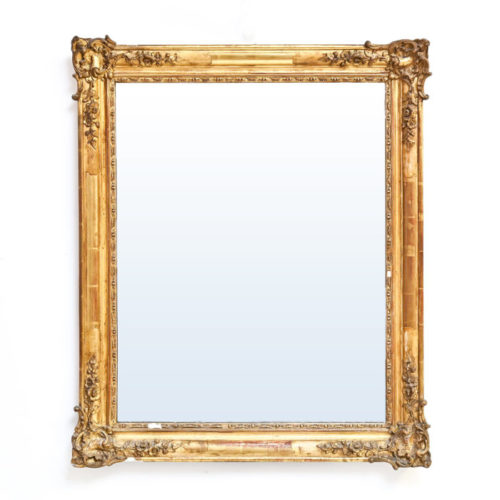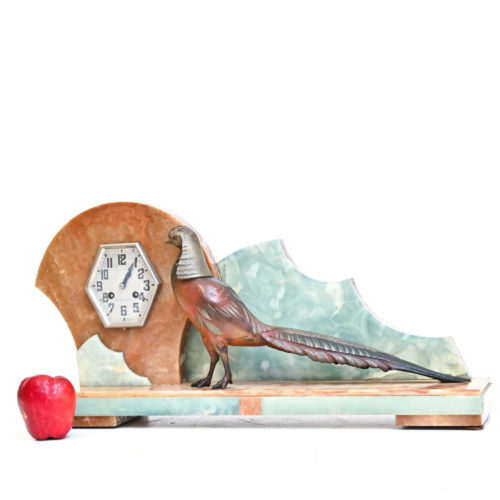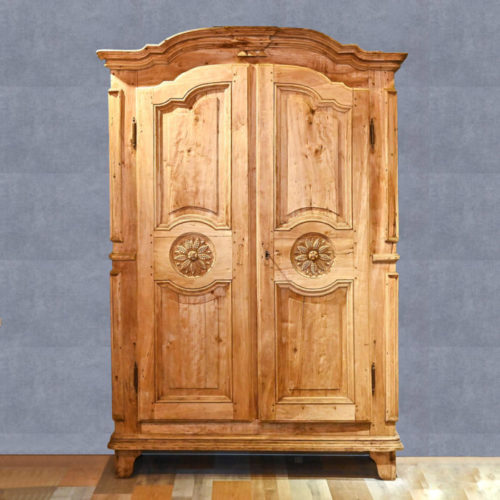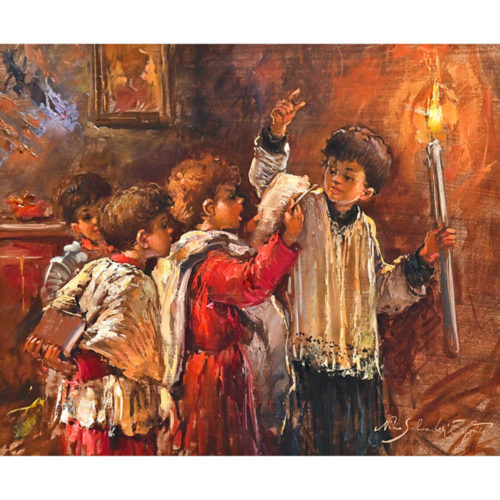-
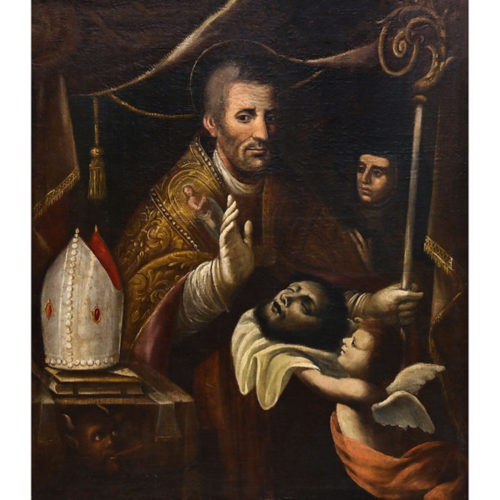 "San Grato Di Aosta with the head of the Baptist" oil on canvas from the first half of the 18th century. The work has been restored. An important legend flourished on the account of San Grato, now proven to be completely anachronistic, which goes by the name of Magna legenda Sancti Grati and is attributed to canon Jacques des Cours, who lived in the 13th century. The story of the discovery of the head of St. John the Baptist, a relic often associated with San Grato in popular iconography, dates back to this tradition. Beheaded by a whim of the beautiful Salome, the head of the Forerunner by order of King Herod Antipas was buried in a well separated from his body, for fear that he might miraculously rejoin it and John might rise again. Grato had a vision from the Lord, in which he was shown the secret location of the burial. He left Aosta in the company of his companion Giocondo, received the Pope's blessing in Rome and then embarked for the Holy Land. During the crossing, a great storm broke out, which threw terror among the sailors, but Grato, raised his arms to the sky, which instantly returned calm. When he arrived in Macheron, near the ruins of Herod's castle, an angel guided him, taking him by the hand and leading him to the well where the head of the Baptist had been for centuries. Immediately the relic rose to the surface and settled in Grato's outstretched palms. Period: First half of the 18th century Measurements: H 110.5 x W 97 x D 2 cm
"San Grato Di Aosta with the head of the Baptist" oil on canvas from the first half of the 18th century. The work has been restored. An important legend flourished on the account of San Grato, now proven to be completely anachronistic, which goes by the name of Magna legenda Sancti Grati and is attributed to canon Jacques des Cours, who lived in the 13th century. The story of the discovery of the head of St. John the Baptist, a relic often associated with San Grato in popular iconography, dates back to this tradition. Beheaded by a whim of the beautiful Salome, the head of the Forerunner by order of King Herod Antipas was buried in a well separated from his body, for fear that he might miraculously rejoin it and John might rise again. Grato had a vision from the Lord, in which he was shown the secret location of the burial. He left Aosta in the company of his companion Giocondo, received the Pope's blessing in Rome and then embarked for the Holy Land. During the crossing, a great storm broke out, which threw terror among the sailors, but Grato, raised his arms to the sky, which instantly returned calm. When he arrived in Macheron, near the ruins of Herod's castle, an angel guided him, taking him by the hand and leading him to the well where the head of the Baptist had been for centuries. Immediately the relic rose to the surface and settled in Grato's outstretched palms. Period: First half of the 18th century Measurements: H 110.5 x W 97 x D 2 cm -
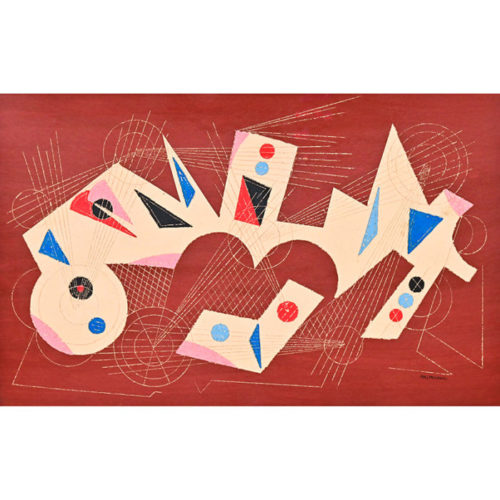 "Composition" by Umberto Mastroianni (Fontana Liri 1910 - Marino 1998), mixed technique / cardboard signed on the lower right, work number 0019. Authentication of the artist on photo. Umberto Mastroianni was born in Fontana Liri, in the province of Frosinone, on 21 September 1910. After his studies at the Academy of San Marcello in Rome, he moved with his family to Turin, continuing his training under the guidance of the master Guerrisi. His first works have a futurist imprinting; in particular he will be influenced by the works of Boccioni which Mastroianni tinges with neo-Cubism. The artist will be the founder of the Turin Prize in 1947 and, during his life, will receive important awards such as the International Grand Prize for Sculpture (Venice Biennale 1958) and the Tokyo Imperial Prize (1989). World famous artist, Umberto Mastroianni died on February 25, 1998 in his house-museum in Marino (Rome), leaving many masterpieces to posterity. Measurements: In frame H 77.5 x W 93.5 cm x D 5.5 / Canvas H 48.5 x W 65.5 cm
"Composition" by Umberto Mastroianni (Fontana Liri 1910 - Marino 1998), mixed technique / cardboard signed on the lower right, work number 0019. Authentication of the artist on photo. Umberto Mastroianni was born in Fontana Liri, in the province of Frosinone, on 21 September 1910. After his studies at the Academy of San Marcello in Rome, he moved with his family to Turin, continuing his training under the guidance of the master Guerrisi. His first works have a futurist imprinting; in particular he will be influenced by the works of Boccioni which Mastroianni tinges with neo-Cubism. The artist will be the founder of the Turin Prize in 1947 and, during his life, will receive important awards such as the International Grand Prize for Sculpture (Venice Biennale 1958) and the Tokyo Imperial Prize (1989). World famous artist, Umberto Mastroianni died on February 25, 1998 in his house-museum in Marino (Rome), leaving many masterpieces to posterity. Measurements: In frame H 77.5 x W 93.5 cm x D 5.5 / Canvas H 48.5 x W 65.5 cm -
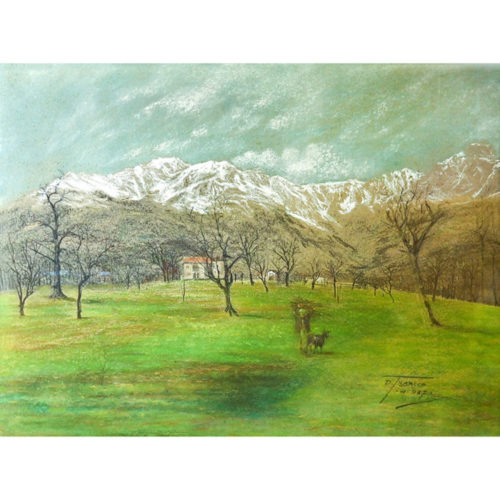 "Biella mountains seen from the Campra plateau" (Graglia) pastel on cardboard by Demetrio Tabacco. Work of March 1937, signed and dated on the lower right. Demetrio Tabacco (Turin 1886 -?) spent some time in the studio of Tommaso Ruffo in Turin. He made his debut in Biella in 1921; he later exhibited his works in Turin, Vercelli, Novara and Tripoli. In this last city he had lived from 1916 to 1918, faithfully portraying types and aspects of environment and manners. He treated landscapes, but he preferred depicting figures. Period: March 1937 Measurements: In frame H 77.5 x W 93.5 cm x D 5.5 / Canvas H 48.5 x W 65.5 cm
"Biella mountains seen from the Campra plateau" (Graglia) pastel on cardboard by Demetrio Tabacco. Work of March 1937, signed and dated on the lower right. Demetrio Tabacco (Turin 1886 -?) spent some time in the studio of Tommaso Ruffo in Turin. He made his debut in Biella in 1921; he later exhibited his works in Turin, Vercelli, Novara and Tripoli. In this last city he had lived from 1916 to 1918, faithfully portraying types and aspects of environment and manners. He treated landscapes, but he preferred depicting figures. Period: March 1937 Measurements: In frame H 77.5 x W 93.5 cm x D 5.5 / Canvas H 48.5 x W 65.5 cm -
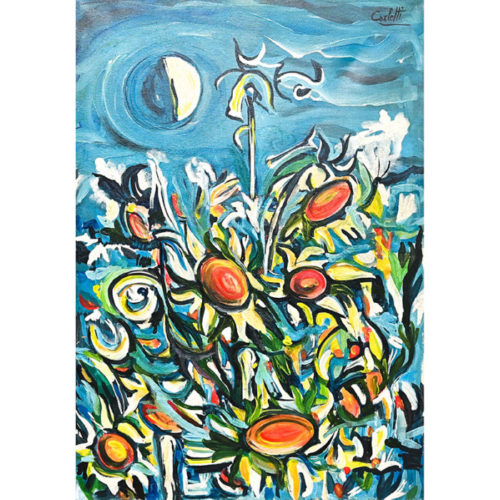 "Flowers and Moon" Oil on canvas by Mario Carletti from the 60s / 70s. Carletti Mario (Turin 1912 - Cossato 1977), a Piedmontese painter and engraver, he painted views, landscapes, portraits and works of sacred art. He exhibited at the Venice Biennale in 1942 and at the Rome Quadriennale in 1956. Period: 60s / 70s Measurements: H 100 x W 70 x D 2 cm
"Flowers and Moon" Oil on canvas by Mario Carletti from the 60s / 70s. Carletti Mario (Turin 1912 - Cossato 1977), a Piedmontese painter and engraver, he painted views, landscapes, portraits and works of sacred art. He exhibited at the Venice Biennale in 1942 and at the Rome Quadriennale in 1956. Period: 60s / 70s Measurements: H 100 x W 70 x D 2 cm -
Out of stock
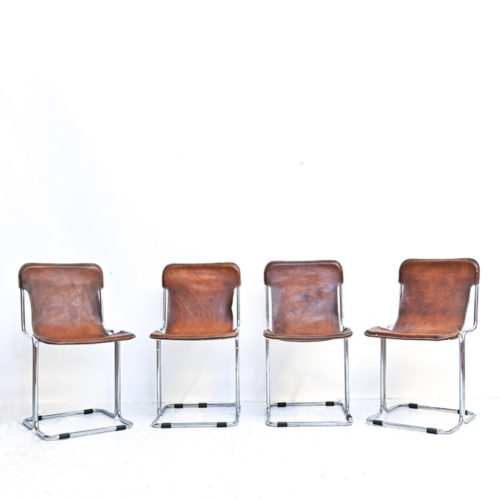 Group of 4 chairs by Antonio Ari Colombo in chromed iron and leather from the 1960s. The leather is in excellent condition, structures to be polished, two screws are missing. Period: 1960s Measurements: H 81 x W 44 x D 50 cm / H seat 46 cm
Group of 4 chairs by Antonio Ari Colombo in chromed iron and leather from the 1960s. The leather is in excellent condition, structures to be polished, two screws are missing. Period: 1960s Measurements: H 81 x W 44 x D 50 cm / H seat 46 cm -
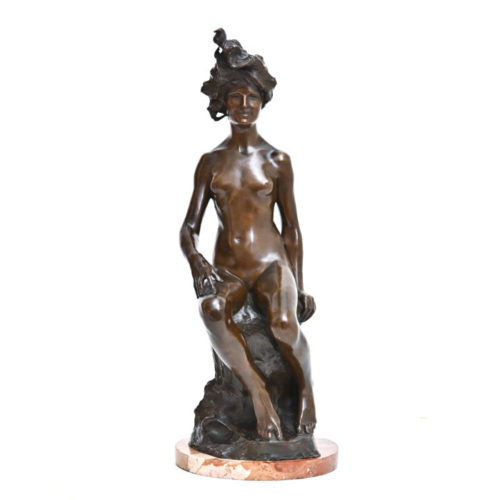 Bronze by Giovanni Nicolini, work of the 1920s / 1930s. Giovanni Nicolini was born in Palermo on April 14, 1872. He died in Rome in 1956. In the 1920s / 1930s the author focused his formal research on the theme of the nude figure, giving life to works strongly expressive of feelings or passions, in which the female figure with floating hair and enveloping shapes revealed a strong art nouveau influence. Period: 1920s / 30s Measurements: H with base 51 cm / H 49 x Ø base 19 cm
Bronze by Giovanni Nicolini, work of the 1920s / 1930s. Giovanni Nicolini was born in Palermo on April 14, 1872. He died in Rome in 1956. In the 1920s / 1930s the author focused his formal research on the theme of the nude figure, giving life to works strongly expressive of feelings or passions, in which the female figure with floating hair and enveloping shapes revealed a strong art nouveau influence. Period: 1920s / 30s Measurements: H with base 51 cm / H 49 x Ø base 19 cm -
Out of stock
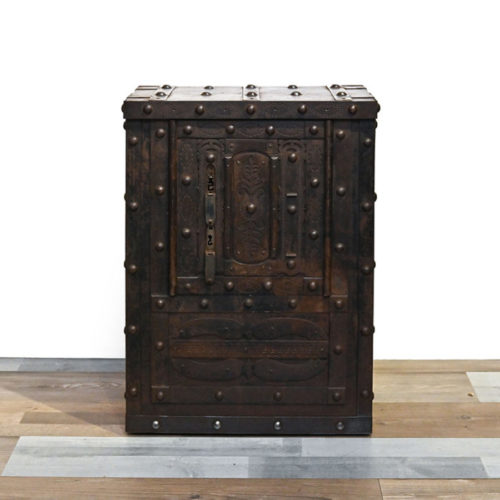 Piedmontese safe from the mid-19th century fully studded, with double lock. Inside there are two wooden drawers. In good condition. Period: Mid 19th century Measurements: H 76 x W 55.5 x D 32 cm
Piedmontese safe from the mid-19th century fully studded, with double lock. Inside there are two wooden drawers. In good condition. Period: Mid 19th century Measurements: H 76 x W 55.5 x D 32 cm -
Out of stock
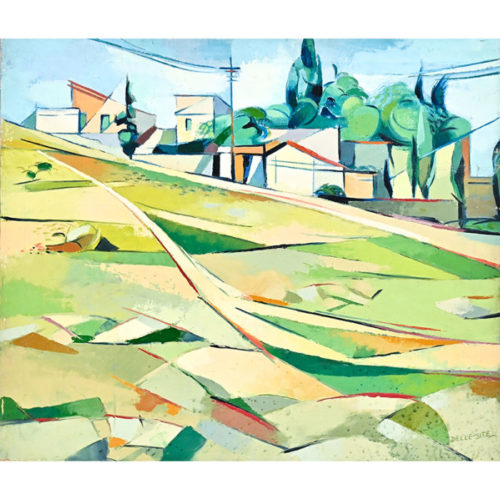 "Landscape on the Via Cassia" oil on canvas by Mino Delle Site. The work is signed at the bottom right Delle Site, listed in the catalog of the IV exhibition of figurative arts of Rome and Lazio, 1963, Galleria SPQR. On the back it has the gallery label. Mino Delle Site (Lecce 1914 - Rome 1996) had first studied in his city and then graduated from the Academy of Fine Arts in Rome. He took part to the Futurist Movement, from which he later broke away in search of new aesthetic expressions. He participated in the First Biennial of Palermo, the Second and Third Quadiennials of Rome and the Venice Biennials of 1934, 1936, 1938. In 1956 he presented in Rome an anthological exhibition summarizing twenty-five years of artistic activity; in 1957 he set up another solo exhibition in Rome, at the Aliberti Gallery; and he also participates in the VI, VII and VIII Roman Quadrennial. In 1965 he exhibited in the USA, at the Rizzoli Gallery in New York with a personal anthological exhibition, works from 1932 to 1965. He won numerous competitions and prizes: in 1936 a prize for Mural Painting; in 1946 a prize for the Female Nude; in 1950 a "Attic" award. He has made decorations and mosaics for public and private entities. His works can be found in both Italian and foreigner public and private collections. Period: 1963 Measurements: H 55 x W 65 x D 1.5 cm
"Landscape on the Via Cassia" oil on canvas by Mino Delle Site. The work is signed at the bottom right Delle Site, listed in the catalog of the IV exhibition of figurative arts of Rome and Lazio, 1963, Galleria SPQR. On the back it has the gallery label. Mino Delle Site (Lecce 1914 - Rome 1996) had first studied in his city and then graduated from the Academy of Fine Arts in Rome. He took part to the Futurist Movement, from which he later broke away in search of new aesthetic expressions. He participated in the First Biennial of Palermo, the Second and Third Quadiennials of Rome and the Venice Biennials of 1934, 1936, 1938. In 1956 he presented in Rome an anthological exhibition summarizing twenty-five years of artistic activity; in 1957 he set up another solo exhibition in Rome, at the Aliberti Gallery; and he also participates in the VI, VII and VIII Roman Quadrennial. In 1965 he exhibited in the USA, at the Rizzoli Gallery in New York with a personal anthological exhibition, works from 1932 to 1965. He won numerous competitions and prizes: in 1936 a prize for Mural Painting; in 1946 a prize for the Female Nude; in 1950 a "Attic" award. He has made decorations and mosaics for public and private entities. His works can be found in both Italian and foreigner public and private collections. Period: 1963 Measurements: H 55 x W 65 x D 1.5 cm
